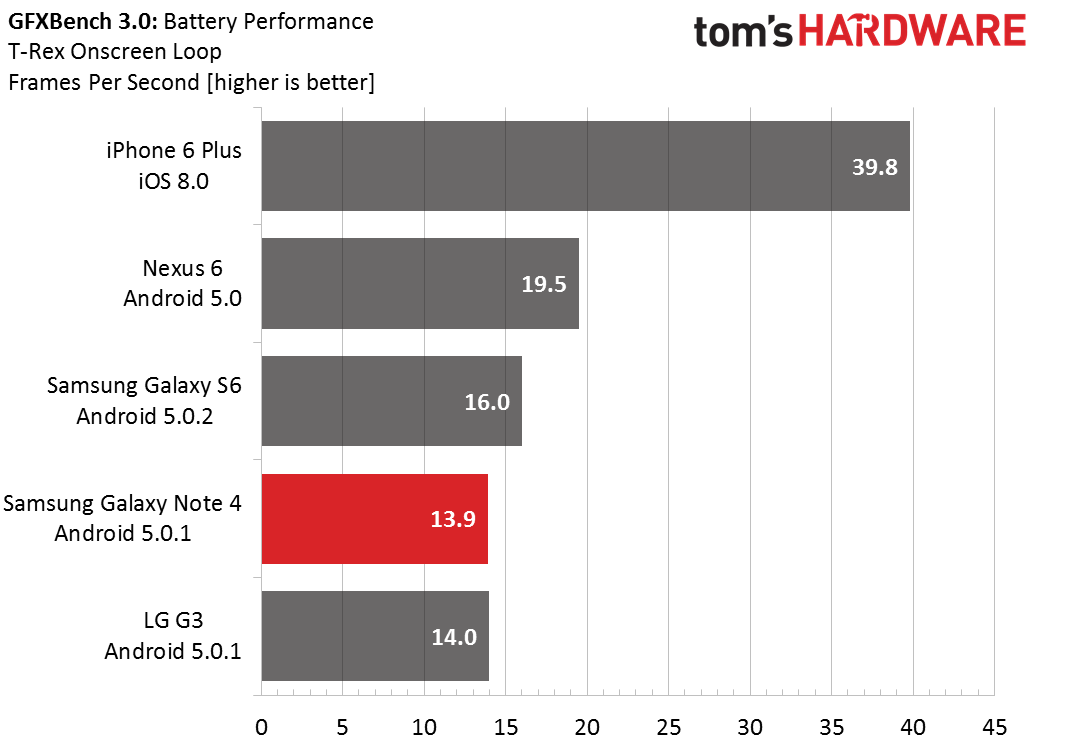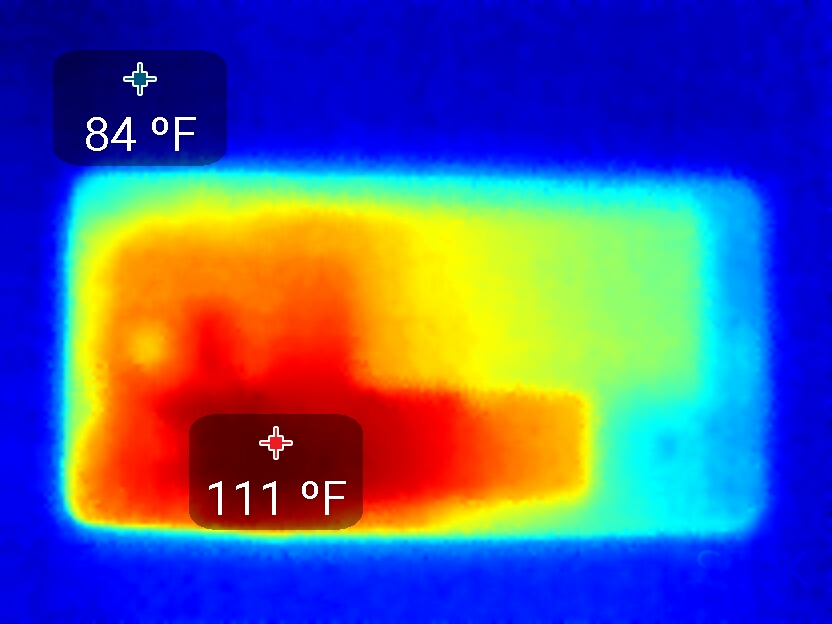Samsung Galaxy Note 4 Review
The Samsung Galaxy Note 4 sports a big, high-quality screen; large, removable battery; speedy processor; stylus; and specialized software for power users.
Why you can trust Tom's Hardware
Battery Life And Thermal Throttling
Battery life may be the most important performance metric for a mobile device. After all, it doesn't matter how quickly a phone or tablet can load webpages or how many frames per second the GPU can crank through once the battery runs down and the device shuts off. To learn more about how we test this critical facet of mobile computing, please read our battery testing methodology article.


The Galaxy Note 4 manages to last an impressive 6 hours 49 minutes in PCMark, currently our best test for real-world battery life. It even outlasts the Nexus 6 despite using the same SoC. One reason for this has to do with CPU frequency. In the chart above, the Nexus 6 was still running Android 5.0, where it maintained a higher average CPU frequency, even holding two cores at max frequency (2649MHz) for the Writing test. The Note 4's CPU governor, in comparison, allows the frequency to bounce around, rarely going above 1497MHz.
Having full disk encryption enabled and handled solely in software also hurts performance and battery life on the Nexus 6. The PCMark workloads have several small read and write operations that add up over several hours, particularly in the Writing and Photo Editing tasks. The Android 5.1 update for the Nexus 6 disables the CPU thread migration boost feature, improving battery life to 354 minutes but slightly lowering performance.


At first glance, the Note 4 appears to do well in the GPU/gaming focused GFXBench battery test, lasting longer than the Nexus 6 and iPhone 6 Plus. It's not until we look at the performance chart that we understand why. The Note 4 shows a 40% reduction in performance relative to the Nexus 6 due to thermal throttling. With the GPU frequency scaled back, it uses less power and lasts longer.



Looking at the battery drain and performance graph above from the GFXBench battery test, we can see the Note 4 throttle back to less than 50% about 8.5 minutes into the test before recovering to about 70% of the original value over the last half. Heat dissipation is a design weak point, which is evident in the thermal image of the back cover taken during the same battery test. It's certainly obvious where the SoC is located (the yellow circle is the rear camera and the green rectangle in the upper-right is the battery). The chassis does a poor job of spreading and dissipating the heat generated by the GPU, making the Note 4 more susceptible to thermal throttling.
You should not have an issue getting through the day on a single charge with the Note 4; however, it does have a power saving mode that restricts background data transfers and performance, even an optional grayscale display mode, for stretching battery life a little further. If you're really desperate, the ultra power saving mode limits what apps can be used and switches to a simple black-and-white display mode.
The Note 4 comes with Samsung's Fast Charge feature, which is compatible with Qualcomm’s Quick Charge 2.0, that can charge the battery to 50% in about 30 minutes, according to Samsung.
Get Tom's Hardware's best news and in-depth reviews, straight to your inbox.
Current page: Battery Life And Thermal Throttling
Prev Page GPU And Gaming Performance Next Page Conclusion-
ZolaIII All in all nice review but I somehow feel you skipped a litle audio section. Not that I blame you much for it as Qualcomms solution is nothing special & it's far behind WolfsonMicro's WM5110 used on Exunos equipped models. Looks like you still didn't got to the bottom of bus frequency scaling dependencies on this Qualcomms SoC gen. ??Reply -
Vorador2 Replythis came out long ago!
It's a tradition. Everybody reviews phones in the week before or after a phone is released.
Tomshardware is better than that. Fashionably late to the party. -
jafrugh Replythis came out long ago!
It's a tradition. Everybody reviews phones in the week before or after a phone is released.
Tomshardware is better than that. Fashionably late to the party.
Well if you think Toms's Hardware needs to be quicker on the draw for phone reviews, go to this article: http://www.tomshardware.com/news/mobile-editors-wanted,29105.html -
Vlad Rose Replythis came out long ago!
I thought the same thing considering I'm using a Note 4 Edge right now... lol -
alex davies Replythis came out long ago!
The difference between our review and others is that we tested the Note 4 running the Lollipop update, which only came out recently.
We also compare its performance to newer devices such the Galaxy S 6, so you can see how the Note 4's older SoC compares to the latest and greatest. -
MobileEditor ReplyAll in all nice review but I somehow feel you skipped a litle audio section. Not that I blame you much for it as Qualcomms solution is nothing special & it's far behind WolfsonMicro's WM5110 used on Exunos equipped models. Looks like you still didn't got to the bottom of bus frequency scaling dependencies on this Qualcomms SoC gen. ??
I agree with you regarding our audio testing. I'm definitely not happy with it. We need to acquire some testing equipment, but the hardware we found cost $30k!!! Needless to say, we're still using my ears, because they're cheap.
If you, or any of our readers, could point me towards some audio testing equipment that mere mortals can afford, please PM me.
I did not investigate the bus scaling on the Note 4, partly because this review was finished by then and partly because the Note 4 did not exhibit "unusual" behavior. We will be examining this for the GS6.
- Matt H. -
10tacle Nice review and very useful to people like me needing an upgrade after skipping two generations of smart phones. I usually keep mine 3 years, and my Droid Bionic is like running a Core 2 Duo desktop these days. I'm still debating between the Note or Galaxy. Apples are out because 1) I don't like the fact that the battery *cannot* be removed to completely shut the phone off, and 2) no MicroSD slot for memory expansion.Reply
There will come a time when all smart phones from all manufacturers no longer allow SD memory upgrades, and I think that time is coming sooner rather than later. After all, one can go buy a 128GB $100 MicroSD card, but if Apple users want a 128GB phone, they have to shell out another $200 clams from the base 16GB model, and they don't get the extra "free" GB memory to start with after upgrading that came with the Android.
But with that said, there are some people reporting about overheating and battery drain with their Note 4. Battery drain can be a problem with the provider though like a cell tower being down. Plus, the Note 5 is coming in a few months, possibly in July. I'm hoping it still has an SD slot otherwise I'll get the 4 and hope the serious overheating and battery drain reports are a fluke.